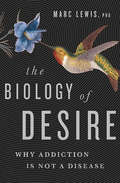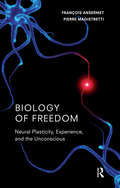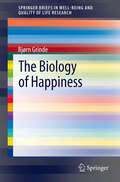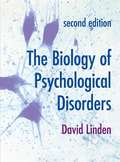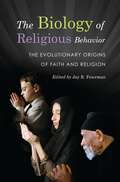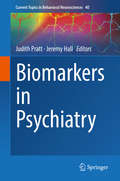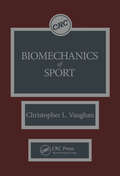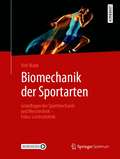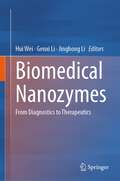- Table View
- List View
The Biology of Desire: Why Addiction Is Not a Disease (The\addicted Brain Ser.)
by Marc LewisThrough the vivid, true stories of five people who journeyed into and out of addiction, a renowned neuroscientist explains why the "disease model" of addiction is wrong and illuminates the path to recovery.The psychiatric establishment and rehab industry in the Western world have branded addiction a brain disease. But in The Biology of Desire, cognitive neuroscientist and former addict Marc Lewis makes a convincing case that addiction is not a disease, and shows why the disease model has become an obstacle to healing.Lewis reveals addiction as an unintended consequence of the brain doing what it's supposed to do-seek pleasure and relief-in a world that's not cooperating. As a result, most treatment based on the disease model fails. Lewis shows how treatment can be retooled to achieve lasting recovery. This is enlightening and optimistic reading for anyone who has wrestled with addiction either personally or professionally.
The Biology of Early Life Stress: Understanding Child Maltreatment and Trauma (Child Maltreatment Solutions Network)
by Jennie G. Noll Idan ShalevThis innovative collection extends the emerging field of stress biology to examine the effects of a substantial source of early-life stress: child abuse and neglect. Research findings across endocrinology, immunology, neuroscience, and genomics supply new insights into the psychological variables associated with adversity in children and its outcomes. These compelling interdisciplinary data add to a promising model of biological mechanisms involved in individual resilience amid chronic maltreatment and other trauma. At the same time, these results also open out distinctive new possibilities for serving vulnerable children and youth, focusing on preventing, intervening in, and potentially even reversing the effects of chronic early trauma.Included in the coverage:Biological embedding of child maltreatmentToward an adaptation-based approach to resilience Developmental traumatology: brain development and maltreated children with and without PTSDChildhood maltreatment and pediatric PTSD: abnormalities in threat neural circuitryAn integrative temporal framework for psychological resilienceThe Biology of Early Life Stress is important reading for child maltreatment researchers; clinical psychologists; educators in counseling, psychology, trauma, and nursing; physicians; and state- and federal-level policymakers. Advocates, child and youth practitioners, and clinicians in general will find it a compelling resource.
Biology of Freedom: Neural Plasticity, Experience, and the Unconscious
by Francois Ansermet Pierre MagistrettiThis groundbreaking book delivers a much needed bridge between the neurosciences and psychoanalysis. Freud hoped that the neurosciences would offer support for his psychoanalysis theories at some point in the future: both disciplines, after all, agree that experience leaves traces in the mind. But even today, as we enter the twenty-first century, all too many scientists and analysts maintain that each side has wholly different models of the origin and nature of those traces. What constitutes human experience, how does this experience shape us, and how, if at all, do we change our lives? Psychoanalysis and the neurosciences have failed to communicate about these questions, when they have not been frankly antagonistic. But, in Biology of Freedom, Francois Ansermet and Pierre Magistretti are at last breaking new ground. This fully illustrated account, rigorous yet lucid and entirely accessible, shows how the plasticity of the brain's neural network allows for successive inscriptions, transcriptions, and retranscriptions of experience, leading to the constitution of an inner reality, an unconscious psychic life unique to each individual.
Biology of Freedom: Neural Plasticity, Experience, and the Unconscious
by Francois Ansermet Pierre MagistrettiThis groundbreaking book delivers a much needed bridge between the neurosciences and psychoanalysis. Freud hoped that the neurosciences would offer support for his psychoanalysis theories at some point in the future: both disciplines, after all, agree that experience leaves traces in the mind. But even today, as we enter the twenty-first century, all too many scientists and analysts maintain that each side has wholly different models of the origin and nature of those traces. What constitutes human experience, how does this experience shape us, and how, if at all, do we change our lives? Psychoanalysis and the neurosciences have failed to communicate about these questions, when they have not been frankly antagonistic. But, in Biology of Freedom, Francois Ansermet and Pierre Magistretti are at last breaking new ground. This fully illustrated account, rigorous yet lucid and entirely accessible, shows how the plasticity of the brain's neural network allows for successive inscriptions, transcriptions, and retranscriptions of experience, leading to the constitution of an inner reality, an unconscious psychic life unique to each individual.
The Biology of Happiness (SpringerBriefs in Well-Being and Quality of Life Research)
by Bjørn GrindeThe brief presents a model for happiness based on current knowledge in evolutionary biology and neurobiology. Briefly, the primary purpose of nervous systems is to direct an animal toward behaviour relevant for survival and procreation. In primitive animals actions are based on reflexes, while in humans the modules directing behaviour engage positive and negative affect (good and bad feelings), and they are swayed by cognitive processes. The reason why evolution opted for this strategy was the improved flexibility in response – i.e., we learn from previous experiences. The human capacity for happiness is an accidental consequence.An array of brain modules has evolved to care for various pursuits, but recent studies suggest that they converge on shared neural circuits designed to generate positive and negative mood. Happiness can be construed as the net output of the relevant modules. The briefs suggests a strategy for how to avoid having negative feelings (such as anxiety, depression and chronic pain) dominate the mind, and how to exercise positive feelings. In short, the book offers both a deeper understanding of what happiness is about, and a framework for improving well-being.An array of brain modules has evolved to care for various pursuits, but recent studies suggest that they converge on shared neural circuits designed to generate positive and negative mood. Happiness can be construed as the net output of the relevant modules. The book suggests a strategy for how to avoid having negative feelings (such as anxiety, depression and chronic pain) dominate the mind, and how to exercise positive feelings. In short, the book offers both a deeper understanding of what happiness is about, and a framework for improving well-being.
The Biology of Human Conduct: East-West Models of Temperament and Personality
by G. L. ManganThe Biology of Human Conduct: East-West Models of Temperament and Personality is a three-part book that explores models of temperament, typology and personality, and personality and conditioning. The first part has four chapters detailing the behavior genetic model; typological models; human typology and higher mental processes; and interactional approach to development. The second part covers theories of personality; strength of the nervous system; the orientation reaction; mobility, concentration, and lability; and the structure of nervous system properties. The last part shows sources of variance in conditioning and socialization.
The Biology of Moral Systems
by Richard AlexanderFirst published in 1987, this book discusses the life and natural history of moral systems as seen through the eyes of a biologist. The volume offers a comprehensive introspective of the biology of a moral system by examining the evolutionary approach from perspectives of sociobiology and ideology. Morality in relation to conflicts and confluences of interest among humankind are further evaluated, with particular emphasis on the human psyche and the ontogeny of moral behaviour. Philosophical meets biological with insightful commentary on the morality of law and democracy. The book concludes with an epilogue, bibliography and name and subject index. It is clear, concise and contemporary and would be of use to those studying Biology, Philsophy and many other social sciences.
The Biology of Moral Systems
by Richard AlexanderFirst published in 1987, this book discusses the life and natural history of moral systems as seen through the eyes of a biologist. The volume offers a comprehensive introspective of the biology of a moral system by examining the evolutionary approach from perspectives of sociobiology and ideology. Morality in relation to conflicts and confluences of interest among humankind are further evaluated, with particular emphasis on the human psyche and the ontogeny of moral behaviour. Philosophical meets biological with insightful commentary on the morality of law and democracy. The book concludes with an epilogue, bibliography and name and subject index. It is clear, concise and contemporary and would be of use to those studying Biology, Philsophy and many other social sciences.
The Biology of Psychological Disorders
by David LindenThis textbook introduces the reader to some of the most common psychological disorders, from schizophrenia, depression and substance abuse to disorders of childhood, adolescence and ageing. Coverage of these disorders is combined with a comprehensive grounding in the fundamentals of neurobiology and the principles of psychopharmacology that underpin their treatment.Written by Professor of Translational Neuroscience at Cardiff University, The Biology of Psychological Disorders sits at the intersection psychology, psychiatry, biology and neuroscience. Aimed primarily at undergraduate psychology students, it is also of relevance to trainee psychiatrists as well as clinicians. written with the academic rigour and incisive approach of Professor David Linden, students are exposed to balanced accounts of biopsycholgical theory
The Biology of Psychological Disorders
by David LindenThis textbook introduces the reader to some of the most common psychological disorders, from schizophrenia, depression and substance abuse to disorders of childhood, adolescence and ageing. Coverage of these disorders is combined with a comprehensive grounding in the fundamentals of neurobiology and the principles of psychopharmacology that underpin their treatment.Written by David Linden, Scientific Director at the School of Mental Health and Neuroscience at Maastricht University, The Biology of Psychological Disorders sits at the intersection psychology, psychiatry, biology and neuroscience. Aimed primarily at undergraduate psychology students, it is also of relevance to trainee psychiatrists and clinicians.New to this Edition:- Two completely new chapters on the immune system and mental health, and on environmental influences on brain development- Incorporates recent advances in genetics and psychopharmacology- Updated chapters in accordance with the DSM-5- Discusses biological aspects of psychological interventions and psychological disease models- Suitable for neuroscience curriculum for trainee psychiatrists- New 'controversies' feature that promotes critical thinking skills by exploring the validity of disease concepts and evidence bases
The Biology Of Psychological Disorders (PDF)
by David LindenPsychological disorders – their origins, clinical symptoms and treatment – have a central place in contemporary public health debate. Understanding how disruptions in the brain's biological mechanisms can influence our thoughts, feelings and actions is one of the most exciting challenges for psychologists in the twenty-first century. The Biology of Psychological Disorders is an authoritative account of some of the most prevalent psychological disorders, from schizophrenia, depression, mania and substance abuse to disorders of childhood, adolescence and ageing. Detailed and engaging coverage of these disorders is combined with a comprehensive grounding in the fundamentals of neuroscience and the principles of psychopharmacology that underpin their treatment. Drawing on the fields of psychology, psychiatry, neuroscience and biology, this highly relevant text is an invaluable resource for students of biological psychology and psychopharmacology, trainee psychiatrists and anyone interested in understanding, researching and treating psychological disorders.
The Biology of Religious Behavior: The Evolutionary Origins of Faith and Religion (Non-ser.)
by Jay R. FeiermanOffers a fresh and detailed take on the evolution of religious behavior from a biobehavioral perspective, promoting a new understanding that may help build bridges across the religious divide.There has been much recent interest in the study of religion from the perspective of Darwinian evolution. The Biology of Religious Behavior: The Evolutionary Origins of Faith and Religion offers a broad overview of the topic, written by internationally recognized experts. In addition to its primary focus on religious behavior, the book addresses other important aspects of religion, such as values, beliefs, and emotions as they affect behavior. The contributors approach the evolution of religion by examining the behavior of individuals in their everyday lives. After describing various religious behaviors, the contributors consider the behaviors with reference to their evolutionary history, development during the lifetime of the individual, proximate causes, and adaptive value. Happily, this foray into understanding religion from a biobehavioral perspective demonstrates that, at the biological and behavioral levels, what unites the different religions of the world is far greater than what divides them.
The Biology of Thought: A Neuronal Mechanism in the Generation of Thought - A New Molecular Model
by Krishnagopal DharaniThe question of "what is thought" has intrigued society for ages, yet it is still a puzzle how the human brain can produce a myriad of thoughts and can store seemingly endless memories. All we know is that sensations received from the outside world imprint some sort of molecular signatures in neurons – or perhaps synapses – for future retrieval. What are these molecular signatures, and how are they made? How are thoughts generated and stored in neurons? The Biology of Thought explores these issues and proposes a new molecular model that sheds light on the basis of human thought. Step-by-step it describes a new hypothesis for how thought is produced at the micro-level in the brain – right at the neuron. Despite its many advances, the neurobiology field lacks a comprehensive explanation of the fundamental aspects of thought generation at the neuron level, and its relation to intelligence and memory. Derived from existing research in the field, this book attempts to lay biological foundations for this phenomenon through a novel mechanism termed the "Molecular-Grid Model" that may explain how biological electrochemical events occurring at the neuron interact to generate thoughts. The proposed molecular model is a testable hypothesis that hopes to change the way we understand critical brain function, and provides a starting point for major advances in this field that will be of interest to neuroscientists the world over.Written to provide a comprehensive coverage of the electro-chemical events that occur at the neuron and how they interact to generate thoughtProvides physiology-based chapters (functional anatomy, neuron physiology, memory) and the molecular mechanisms that may shape thoughtContains a thorough description of the process by which neurons convert external stimuli to primary thoughts
Biomarkers and Mental Illness: It’s Not All in the Mind
by Paul C. GuestEmploying accessible language throughout, this book covers the history of psychiatric research, the current state-of-the art in psychiatric practice, the physiological systems affected by psychiatric illnesses, the whole-body nature of these diseases and the impact that this aspect has on emerging biomarker discoveries. Further, it provides descriptions of the major specific psychiatric disorders and the special challenges regarding the diagnosis and treatment of each. The book concludes with insights into the latest developments in hand-held biomarker test devices, which can provide diagnostic information in less than 15 minutes in point-of-care settings.This book investigates the emerging use of biomarkers in the study of psychiatric diseases, a topic of considerable importance for a broad range of people including researchers, clinicians, psychiatrists, university students and even those whose lives are affected in some way by a psychiatric illness. The last category is hardly trivial, since a staggering one in three people worldwide show the criteria for at least one psychiatric disorder at some point in their lifetime.
Biomarkers for Psychiatric Disorders
by Christoph W. TurckBiomarkers hold immense promise for the early detection of disease. Unlike other disorders like diabetes and heart disease where a limited number of biological markers are at hand that allow the physician to come up with a reliable diagnosis, there are currently no such markers available for affective disorders. As in any other disease area a major goal is therefore the identification of early markers that can categorize subsets of subjects in a consistent manner. This will allow a more precise definition and categorization of affective disorders and in turn facilitate investigations of the pathogenesis of the diseases and enhance our ability for treatment. This edited volume will not only address the area of affective disorders but also other brain disorders that are neurological in nature, including Multiple Sclerosis and Alzheimer Disease.
Biomarkers in Alzheimer's Disease
by Tapan KhanBiomarkers in Alzheimer’s Disease provides a comprehensive overview of all modalities of Alzheimer’s disease biomarkers, including neuroimaging, cerebrospinal fluid, genomic, and peripheral systems. Each chapter integrates molecular/cellular abnormality due to Alzheimer’s disease and technological advancement of biomarkers techniques. The book is ideal for clinical neuroscience and molecular/cellular neuroscience researchers, psychiatrists, and allied healthcare practitioners involved in the diagnosis and management of patients with cognitive impairment and Alzheimer’s disease, and for differential diagnosis of Alzheimer’s disease with other non-Alzheimer’s dementia.Presents a comprehensive overview detailing all modalities of Alzheimer’s disease biomarkersWritten for neuroscience researchers and clinicians studying or treating patients with Alzheimer’s DiseaseIntegrates, in each chapter, the molecular/cellular abnormality due to Alzheimer’s disease and the technological advancement of biomarkers techniques
Biomarkers in Neuropsychiatry: A Primer
by Michael Berk Antonio L. Teixeira Natalia P. RochaThis book presents the ‘state of the art’ of biomarkers research in neuropsychiatric conditions, from dementia to eating disorders, as well as providing methodological, practical and ethical issues related to the development of biomarkers. Biomarkers have revolutionized clinical research and practice in most fields of medicine, but psychiatry has lagged behind. However, in the last decade, there has been a growing expectation that biomarkers will advance and, ultimately, reframe psychiatry research and practice. Biomarkers might inform about diagnosis, therapeutics, prognosis, contributing to a ‘personalized medicine’. Understanding their meaning, possibilities and limitations will help clinicians, researchers and students in the related areas navigate and excel in the challenging and ever changing field of neuropsychiatric disorders.
Biomarkers in Psychiatry (Current Topics in Behavioral Neurosciences #40)
by Judith Pratt Jeremy HallThis volume addresses one of the Holy Grails in Psychiatry, namely the evidence for and potential to adopt ‘Biomarkers’ for prevention, diagnosis, and treatment responses in mental health conditions. It meshes together state of the art research from international renowned pre-clinical and clinical scientists to illustrate how the fields of anxiety disorders, depression, psychotic disorders, and autism spectrum disorder have advanced in recent years.
Biomarkers of Brain Injury and Neurological Disorders
by Kevin K. W. Wang Zhiqun Zhang Firas H. KobeissyThis book explores the recent advances in the techniques and platforms used in biomarker research that have revolutionized the way we study, diagnose, and treat brain injury conditions. The contributors describe different biomarker studies pertaining to brain injury and other neurological disorders and analyze the different models and technologies
Biomarkers of Postpartum Psychiatric Disorders
by Jennifer L. Payne Lauren M. OsborneBiomarkers of Postpartum Psychiatric Disorders provides an up-to-date reference on the current research relating to biomarkers in psychiatric disorders, including major depressive disorder, OCD and bipolar disorder in the immediate postpartum time-period. It is the only reference on the market that synthesizes and interprets available data and reviews clinical phenotypes. Topics cover hormonal contributions, immunology, epigenetics and neuroimaging. While the risk of psychiatric illness during pregnancy appears to be equivalent to the risk at any other time in a woman’s life, the risk in the immediate postpartum time period is dramatically increased, hence the importance of the discussions in this title. Identifies epigenetic, hormonal, immunological and neuroimaging biomarkersProvides biomarkers for depression, OCD and psychosisIncludes clinical phenotypes for psychiatric disordersDiscusses future research and directions in the field
Biomechanics and Motor Control: Defining Central Concepts
by Mark L. Latash Vladimir ZatsiorskyBiomechanics and Motor Control: Defining Central Concepts provides a thorough update to the rapidly evolving fields of biomechanics of human motion and motor control with research published in biology, psychology, physics, medicine, physical therapy, robotics, and engineering consistently breaking new ground. This book clarifies the meaning of the most frequently used terms, and consists of four parts, with part one covering biomechanical concepts, including joint torques, stiffness and stiffness-like measures, viscosity, damping and impedance, and mechanical work and energy. Other sections deal with neurophysiological concepts used in motor control, such as muscle tone, reflex, pre-programmed reactions, efferent copy, and central pattern generator, and central motor control concepts, including redundancy and abundance, synergy, equilibrium-point hypothesis, and motor program, and posture and prehension from the field of motor behavior. The book is organized to cover smaller concepts within the context of larger concepts. For example, internal models are covered in the chapter on motor programs. Major concepts are not only defined, but given context as to how research came to use the term in this manner. Presents a unified approach to an interdisciplinary, fragmented areaDefines key terms for understandingIdentifies key theories, concepts, and applications across theoretical perspectivesProvides historical context for definitions and theory evolution
Biomechanics of Sport
by Christopher L. VaughanThis informative text features current and thorough reviews of the biomechanics of sport for improved performance, etiology, and pre-vention of injuries. Winter sports and aquatics are covered, with an emphasis on developing training programs for ski-jumping, alpine, and cross country skiing. Other sports featured include modeling perspectives in speed skating, swimming, and the mechanics of rowing and sculling. Track-and-field athletics, ball games, weight lifting, and training are examined in terms of per-formance, safety, and re-search methodology. Sports scientists and sports medicine specialists will find this book invaluable.
Biomechanics of Sport
by Christopher L. VaughanThis informative text features current and thorough reviews of the biomechanics of sport for improved performance, etiology, and pre-vention of injuries. Winter sports and aquatics are covered, with an emphasis on developing training programs for ski-jumping, alpine, and cross country skiing. Other sports featured include modeling perspectives in speed skating, swimming, and the mechanics of rowing and sculling. Track-and-field athletics, ball games, weight lifting, and training are examined in terms of per-formance, safety, and re-search methodology. Sports scientists and sports medicine specialists will find this book invaluable.
Biomechanik der Sportarten: Grundlagen der Sportmechanik und Messtechnik - Fokus Leichtathletik
by Veit WankDieses Lehrbuch bietet einen reichhaltig illustrierten und kompakten Überblick über die kausalen Zusammenhänge, die bei Bewegungsabläufen im Sport auftreten. Sie erlernen damit die Grundkenntnisse im Fach Biomechanik wie auch die wesentlichen biomechanischen Messverfahren und Methoden zur Datenerhebung und Datenauswertung. Dazu erhalten Sie einen umfassenden Einblick in die Strukturen sportlicher Bewegungen. Dabei steht ersten Bandes die Anwendung biomechanischer Analysen in der Leichtathletik im Mittelpunkt. Didaktisch ausgereift werden Ihnen anhand originaler Datenbeispiele von aktuellen Spitzenathleten die Möglichkeiten, die biomechanische Analysen zur Bewertung und Optimierung der sportlichen Technik bieten, anschaulich und gut verständlich erklärt. So können Sie sich optimal auf die Prüfung vorbereiten, dazulernen, nachschlagen oder sich einen Ein- und Überblick verschaffen. Dazu bietet eine Begleitwebseite Online-Zusatzmaterialien zur weiteren Veranschaulichung und Vertiefung. Zielgruppen: Studierende des Faches Sportwissenschaft (Lehramt, Bachelor und Master), besonders geeignet zum Studium und als Prüfungslektüre des Kernfaches Bewegungswissenschaft. Ebenso werden Athleten, Trainer und Leistungsdiagnostiker im leistungsorientierten Sport von diesem Werk profitieren. Das Buch bietet auch eine optimale und kompakte Wissenssammlung für Sportlehrer der gymnasialen Oberstufe (speziell für Neigungsfächer und Leistungskurse).Der Autor: Prof. Dr. Veit Wank ist Professor für Sportwissenschaft und Leiter des Lehrstuhls für Biomechanik, Bewegungs- und Trainingswissenschaft an der Eberhard Karls Universität Tübingen. Seit 2007 ist er Sprecher der Sektion Biomechanik der Deutschen Vereinigung für Sportwissenschaft (DVS). Nach Studien der Sportwissenschaft, Biologie und Physik an der Friedrich-Schiller-Universität Jena arbeitete er als wissenschaftlicher Assistent und in verschiedenen Sportarten als Praxisausbilder an den Universitäten Jena und Karlsruhe. Er war selbst über viele Jahre aktiver Leichtathlet.
Biomedical Nanozymes: From Diagnostics to Therapeutics
by Hui Wei Genxi Li Jinghong LiThis book aims to summarize the latest research progress of biomedical nanozymes in diagnostic and therapeutic related fields. In terms of diagnostics, it will cover in vitro diagnostics, live analysis, and some emerging bioanalysis. In terms of therapeutics, it will introduce antioxidant therapy, peroxidation therapy and emerging therapy respectively. Furthermore, the research results previously scattered in many journals and conferences worldwide are methodically edited and presented in a unified form. Based on the new ideas and developments presented in this book, it will be of interest to readers from different areas, such as chemistry, materials, nanoscience and nanotechnology, biomedical and clinical studies, etc.
